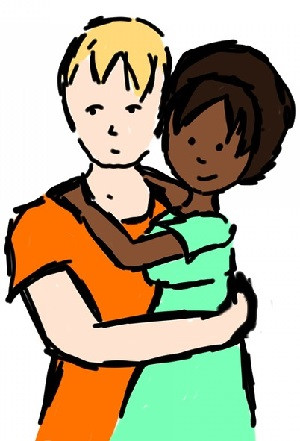The formation of mixed couples that is, those in which there are significant cultural differences between its members (such as country, religious beliefs, language or ethnicity), has had a considerable increase in recent times.
This growth is attributed first of all to the fact that the possibilities of meeting people from other countries have increased due to the intensification of international mobility and the massification of communication through the Internet. In addition to the above, A series of social transformations have been taking place in the field of love that allow people greater amounts of freedom and autonomy when making the marital choice.
Migration for love
Migration in which one of the main motivations is to form a couple or a family is called by some social researchers as migration for love.
This migratory typology is described as a diverse and complex phenomenon that transcends simplifications. and prejudices with which it is usually conceived from common sense.
A basically feminine phenomenon
Different ethnographic research highlights that women express much more frequently than men that their feelings and The desire to start or establish a relationship has been one of the main reasons for geographical displacement The above is attributed to the fact that structural conditions continue to exist for the man to function as a provider in a family and for the woman to prioritize the care of children and the home, leaving her professional development in the background.
Therefore, it is more common for a woman to leave her country and emigrate to her partner’s country or to accompany her partner on a migration for work reasons.
Migration for love is then described as predominantly female and is directed mainly from regions of the Caribbean, Latin America , Eastern Europe and Southeast Asia to rich countries in Western Europe, North America and the Asia-Pacific area. The ease of mobility for European citizens within the EU has also led to a significant increase in the formation of intra-European binational couples.
Mixed couple modalities and their reasons
The differences between people of different cultural origins can be softened or intensified if they share or differ in other characteristics such as: urban or rural lifestyle, educational level, professional field, social class, etc. Sometimes, even though people come from different countries, They share many other factors, resulting in more elements of affinity than distinction
For anthropology it is a verifiable fact that in all cultures people usually bond with members of their own group and that bonding with others is an exception. Choosing a partner who belongs to another culture can be interpreted as a transgression to one’s own culture and family ideals, since a foreigner will transmit values different from one’s own.
In binational mixed couples, country borders are transcended , but the most common thing is that the borders of socioeconomic class and educational level continue to be maintained. It is also possible to observe the existence of a kind of hierarchy of cultural distances, in which certain nationalities or groups of immigrants are considered more or less susceptible to being chosen as a partner. In this hierarchy would be located the nationalities that would be considered totally incompatible to those whose practices and customs are admired.
The exchange of status

Although in smaller proportions, Sometimes in mixed couples, socioeconomic or educational level boundaries are also transcended In these cases an exchange of status may occur. This is the case of people from rich countries (high status) with a low educational level (low status) who marry people from poor countries or belonging to marginalized minorities (low status), who have a high educational level.
The exchange can occur for any element that can be considered a guarantor of status in a person: beauty, age, social category, a nationality that has a certain prestige, etc.
Sociology highlights that Statistically, men tend to marry hypogamously more frequently than women That is, with a partner with a lower socioeconomic level. And, therefore, women tend to marry more frequently in a hypergamous way, that is, with a man who has a higher socioeconomic level. The above is also true for mixed couples, although the educational level achieved by women in recent decades is making the statistical difference increasingly less wide.
It has also been observed that as the educational level increases, the probability of forming a couple with people from different countries also increases. Greater endogamy (that is, the tendency to bond maritally with people of the same culture) occurs more intensely in people with strong religious observance.
The mixed couple as resistance to transformations in gender relations
It is relevant that, according to different research, motivations that have to do with gender are expressed by men and women who decide to establish a relationship with a foreign person.
Gender-related motivations are much more evident in the case of men from rich countries who are looking for a partner abroad, as well as women from those countries where these men focus their search. In relation to the above, it is proposed that the material and sentimental independence acquired by women in the most industrialized countries has generated resistance from some men with respect to this new feminine model.
This resistance drives them to look for a partner in a marriage market different from that of their own country, opting for nationalities in which it is assumed that women maintain a more traditional role. That is They keep family and home as a priority above their profession , and that they would accept gender relations supported by a certain degree of submission and dependence. This stereotype is given, for example, to women from Latin American or Eastern European countries.
The search for a more traditional woman is more urgent in men over 40 years of age, in younger men the prototype of the submissive and housewife woman is less attractive, with other factors influencing more as motivators to establish a relationship with a foreigner..
Longing for polarized gender roles
Some men justify their desire to seek relationships with more traditional women by the conflicts and tensions that they believe were generated by the independence obtained by women in their previous relationships.
The longing for more polarized gender roles is also present in some women from industrialized countries who state that part of their interest in a foreign partner is the desire to relate to men whose way of being is closer to a certain stereotype of traditional masculinity: chivalrous, romantic, passionate, seductive. This type of stereotype is given, for example, to men from Mediterranean or Latin countries. The polarization of genders in these cases is seen as a value of complementarity and also as part of sexual stimulation.
Marriage with a foreigner as a search for equality
Paradoxically, for many Latin American or Eastern European women One of the outstanding motivations for establishing a relationship with a foreign man is the desire to acquire equal shares and emancipation that they do not find in their own context. These women describe gender relations in their countries as more subordinate and inequitable than those they assume exist in their migration destination.
Men from their own country are described as more sexist, controlling, possessive, unfaithful and aggressive. They consider these aspects as rooted in their own culture, and believe that they occur in a much lower intensity in men from the destination country. Some of the women also express their desire to distance themselves from previous experiences of abuse and alcoholism from their ex-partners. In these cases, gender polarization is seen as a manifestation of oppression and inequality
Physical appearance: the ideal and the exotic
The predominant physical appearance in some nationalities is the subject of attributions that nourish the fantasies of men and women , also becoming a factor that influences as a motivator to establish a relationship with a foreign person. It is, in part, the attributions about the sexuality of certain population groups.
This is reflected in research carried out on international matchmaking agencies that operate online. This is the case, for example, of those specialized in Latin American or Eastern European women who highlight the physical characteristics that are supposed to be valued by potential “boyfriends.” One would be the ideal Nordic type (tall, blonde, blue eyes, slender) or the exotic type referred to Latin American women (dark, curvy and sensual).
Marriage as a way to improve living conditions
The cultural model of couples that predominates in the West is based on the ideal of a relationship established by free love and spontaneous, distanced from any calculation or interest. Due to the above, material motivations, which are sometimes interwoven with sentimental ones, tend to be much more hidden in the speeches of women who decide to formalize a relationship with a foreigner.
On many occasions, the countries from which people who emigrate for love come are characterized by high rates of job insecurity, insecurity or other aspects that promote the search for better living conditions. Marriage with a foreign person is one strategy among others to establish yourself in a place that offers better opportunities.
Despite this expectation, people with high levels of training encounter bureaucratic obstacles to be able to perform in the field of their profession and They are forced to do jobs that do not require qualifications
Social pressure in mixed couples
One of the situations that many migrants for love often face is the resistance of their partners’ family and friends who directly or indirectly accuse them of marrying for economic interest or to legalize residence in the country. Many of them say that they constantly have to demonstrate that their marriage is based on feelings and that it has not only had an instrumental nature. Some women consider the arrival of the couple’s first child as a legitimation milestone
In relation to the above, it has been observed that women who migrate for love do not usually seek to establish ties with emigrants of the same nationality in the place of destination. This distancing is sometimes encouraged by their local partners in response to the desire to make a difference with economic migration and the stigmas that surround it.









